Abstract
Content
- Introduction
- 1. Actuality of theme
- 2. Marketing role in area of management by quality
- 3. Analysis of internal and external factors of enterprise (PEST and SWOT is an analysis)
- 3.1 Analysis of external factors of PEST-analysis
- 3.2 Analysis of internal factors of SWOT is an analysis
- 3.3 the Portfolio analysis (matrix of BCG)
- 4. Methodical going near a management by marketing activity of enterprise
- 4.1 Application of PEST-analysis
- 4.2 Application of SWOT-analysis
- 4.3 the Portfolio analysis of services
- Conclusions
- References
Introduction
Role of business-function marketing
in control system consists quality in a search and choice of target market, establishment of requirements to quality of products (services), determination of her necessity, market capacity, in drafting of the detailed description of consumers of this market segment. This information is needed for producing of optimal amount of products fully corresponding to the features of demand of customers in quality, to the price, delivery dates and service.
One of universally recognized in the world are international standards of the systems of management of quality of ISO of series 9000. The system of management of quality worked out in accordance with these standards puts in order the general management of organization on the basis of the system and процессного approaches. Marketing and study of market are the major stage of life cycle of products (services) in accordance with the international standards of ISO.
System requirements marketing are set in a division 7.2 Processes related to the consumer
standard of ISO 9001. The marketing system in organization must embrace actually all stages of life cycle of products and to co-operate with the system of management of quality, executing such functions, as market analysis and determination of requirements in products, requirements of consumers, market demand; planning of basic indexes, characterizing quality of products; estimation of competitiveness of products of organization; exposure of reasons, propulsive a consumer to acquisition exactly of this products; decision of the tasks, related to packing, transporting and editing; establishment of the acceptable assured terms on maintenance of products verification of instructions on exploitation and service; establishment of reverse communication network with consumers and control of the got information; advertisement.
Marketing activity of enterprise is creative administrative activity the task of that consists in market of commodities development, services and labour force by the estimation of necessities of consumers, and also in realization of practical events for satisfaction of these necessities. By means of this activity manufacturabilities and distribution of commodities and services are coordinated, and also determined, what steps must be undertaken, to sell a commodity or service to end-user.
Essence and maintenance of marketing activity reflect the objective terms of market that to a certain extent loses chaoticness and falls under regulative influence beforehand established economic connections development, where the special role is taken to the consumer. A consumer produces the requirements to the product, his технико-экономическим descriptions, amount, delivery (foremost machines and equipment) dates and creates pre-conditions the same for distribution of market between producers. The value of competition increases, fight for a consumer. It compels producers carefully and deeply to study certain potential consumers and queries of market that makes great demand to quality and competitiveness of products.
1. Actuality of theme
Actuality of theme of research of final qualifying work is conditioned by that the methodical going presented in research near a management will give an opportunity to extend the spectrum of services given by an enterprise, increase a profit, improve work by self-examination and exception marketing activity of enterprise, having no prospects business-units and of development of remaining.
2. Marketing role in area of management by quality
A management includes methods and types of activity of operative character, sent both to the management by a process, quality and on the removal of reasons of the unsatisfactory functioning on all stages of life cycle of good (петли qualities) for the achievement of economic efficiency. Under the life cycle of good (by the loop of quality) the conceptual model of interdependent types of activity, influencing on quality on the different stages from determination of necessities to the estimation of their satisfaction, is understood.
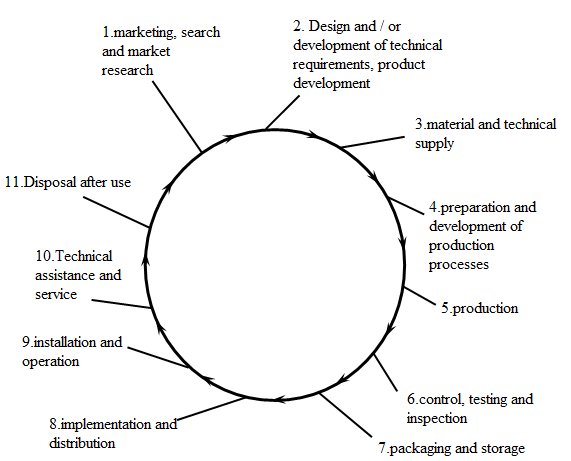
Picture 1 - circle of quality
3. Analysis of internal and external factors of enterprise (PEST and SWOT-analysis)
3.1 Analysis of external factors of PEST-analysis
PEST-analysis - is the simple and comfortable method of analysis of environment of enterprise. Methodology of PEST-analysis often used for the estimation of current position at the market. The results of PEST- of analysis it can draw on for determination of possible threats and their removal at drafting of SWOT- of analysis of company. PEST- an analysis is the long-term instrument of the strategic planning and made on three-five years, with recovery of data every year. PEST not only determines all meaningful factors of environment but also analyses force of their influence on an enterprise in interests that research is conducted. The result of PEST- of analysis can be executed in a table form, or as a matrix from four quadrants.
PEST
it is abbreviation of basic elements of analysis : (Р) political factors, (Е) economic factors, (S) sociocultural factors, (Т) technological factors, we will consider every group in detail.
P (Political) are factors of политико-правового surroundings of company. At his analysis it is recommended to consider the questions of relatively key changes in area of legal adjusting and political stability. It is needed to take into account whether the legislative base of industry in that an enterprise functions and whether changes will influence in a legislative base on activity of enterprise will change in the near time. It is also necessary to pay attention to level of interference the state. As far as he is considerable and whether will increase in the near future. It is important also, then as far as industry is corrupted and as it influences on activity of company. A not insignificant role is played relationship of country with other countries or international organizations, then whether will change, will become complicated or simplified such mutual relations.
E (Economical) are factors of economic market condition. During the analysis of these factors it is necessary to define six basic parameters, that characterize the state of economy of market an enterprise functions on that, :
- a dynamics of development of economy is a slump, height, стагнация;
- tendencies are in a bank sphere;
- change of courses of currencies;
- change of the disposed acuests per capita;
- unemployment rate;
- rate of inflation.
S (Socio - cultural) are sociocultural factors of market condition. During the analysis of factors of this group it is necessary to describe five parameters:
- change of the demographic state, age-related structure of market, change of racial belonging;
- level of form of population;
- features of mentality and cultural values;
- change of social layers of population;
- a change of tastes and preferences is withstand prejudices.
T (Technological) are factors characterizing technological progress. This group of factors requires the detailed analysis, as in exactly a change in technology can cardinally change a withstand market condition. Right to analyse technological factors it is necessary to take into account four main parameters, such as:
- influence of the internet on market development;
- influence of mobile technologies on market development;
- innovations are in technologies allowing effectively to compete at the market;
- possible changes are in the key technologies used at the market.
PEST- an analysis - it just an instrument by means of that it is possible to estimate influence of external factors and риски, and already after on the basis of the obtained data to form strategy. And as any instrument, him it is easily possible to change and transform in new variations.
Conducting PEST-analysis, it is needed to describe not simply current status of every factor, and to forecast his change on a few years forward. Exactly estimation of influence of factor in a long-term prospect on a profit, allows to apply the obtained data for forming of strategy. During an analysis it is necessary to define meaningful factors that is able to influence on the profit of company and when such factors will be certain, the most difficult stage of analysis begins: development of tactical actions that can bring down negative influence of factor on activity and maximize a profit.
3.2 Analysis of internal factors of SWOT is an analysis
SWOT- an analysis is one of the most effective instruments in a strategic management. His essence consists in the analysis of external and internal factors of company, estimation of risks and competitiveness of commodity in industry. Any product, shop, company, plant, country or even man, can become the object of SWOT- of analysis. There are a few types of SWOT- of analysis :
- SWOT-analysis of personality;
- SWOT-analysis of activity of firm;
- SWOT-analysis of activity of organization;
- SWOT-analysis of activity of educational establishment;
- SWOT-analysis of certain territory : country, region, district or city;
- SWOT-analysis of separate project or department;
- SWOT-certain market or industry analysis;
- SWOT-analysis of competitiveness of brand, commodity, product or service.
Often companies conduct SWOT-analysis of not only own products but also products of competitors, as he very evidently systematizes all information about the internal and external environment of any organization.
Advantage of SWOT- of analysis consist in that he allows, unfolded to give a glance on position of company of her commodity or services at the market, and is the most popular instrument in the acceptance of administrative decisions and management рисками.
The result of realization of analysis of enterprise is, acceptance of plan of actions with pointing of terms of implementation, to priority of implementation and by the amount of necessary resources on realization, this plan. SWOT- an analysis it is recommended to conduct minimum one time per a year within the framework of the strategic planning and at forming of budgets. SWOT- an analysis very often is the first step at drafting of marketing plan.
SWOT
it is abbreviation of basic elements of analysis : Strengths (strong parties), Weaknesses (weak parties), Opportunities (possibilities), Threats (threats).
S=Strengths, strong parties of service or commodity. It is internal descriptions companies that provide a competitiveness at the market or more advantageous position on him in a difference from competitors, otherwise speaking areas in that the commodity of company has substantial advantage above competitors. The value of strong parties is extremely great: for their account a company can increase the volume of sales, profits and stake at the market, strong parties provide comfort position of service or commodity at the market in a difference from competitors. Strong parties must be constantly supported at high level, strengthen and variously improve, and similarly to use in intermingling with the consumer of market.
W=Weaknesses, weak parties, lacks of commodity or service. They hamper the height of business, interfere with a commodity to develop at the market and deprive the commodity (service) of competitiveness at the market. Determination of weak parties for a company has a not unimportant value: weak parties of company pull her downward, interfere with the height of sales and deprive profits. From weak parties a company can lose to lose the position at the market in a long-term prospect and to become uncompetitive. It is necessary as possible exactly to define areas in that a company is weak or can lose positions in the visible future, improve them, develop the special programs for minimization of risks of influence of weak parties on efficiency of work of company.
O=Opportunities, possibilities of company are the so-called favourable factors of environment, that can influence or already influence on the height of business. Possibilities of company at the market personify the sources of height of business. Possibilities must be analysed, estimate and develop a plan on their maximally advantageous use with bringing in of strong parties of company.
T=Threats, threats - negative factors that can weaken position of company at the market in the future and to lead to the loss of positions at the market. Determination of threats is very important, as threats mean a danger for a company in the future. Every threat must be appraised from the point of view of probability of origin in the near future and from the point of view of possible losses for a company. Against every threat decisions must be worked out for their removal or minimization.
3.3 the Portfolio analysis (matrix of BCG)
In modern terms a portfolio analysis has large meaningfulness, because his using for development of effective marketing strategy helps a firm to survive in competitive activity in a long-term prospect. Companies in the conditions of hard competition must be concentrated, both on the internal state of businesses and on development of long-term strategy that would allow to retain position them in competitive activity and not grow into a backward link, not having time after changes what be going on in their surroundings. Portfolio analysis - it one of bases of forming of strategy, he allows to determine and choose priority directions of activity, forecast the future structure of company, advantage at financing of projects, and also direction of her changes.
Actuality of the use of portfolio analysis causes large interest, both at home and at foreign scientists and practical workers, therefore there is a great number of points of view on determination of essence of portfolio analysis.
Portfolio strategy is strategy that describes common direction of development of firm with the different types of business and sent to providing of balance of brief-case of commodities and services. The strategic decisions of this level are most difficult, because touch a firm on the whole. Exactly at this level determined, food strategies of firm accord.
The important feature of portfolio strategies is a systematic redistribution of resources between subdivisions of enterprise, on the basis of the special budgets, but not on the basis of commercial risk.
It is based strategy of portfolio analysis of choice of competition position of firm on that if in a competition environment the standard of prices is determined by expenses the least effective, nevertheless necessary for satisfaction existent demand of producer, then an enterprise will always be interested to work in that industry in that it is able to produce products with minimum expenses and sell it at the least price during long time. Thus, an enterprise, it is assured, will take advantage at the market in the results of activity and investing in development of the production.But it is necessary to take into account the life cycles of strategic zones of management. The method of the Bostonian consultative group allows on the basis of study of activity of company to make the optimal portfolio of types of her activity and estimate positions of firms of competitors on attitude toward each other. A model is based on the use of matrix of economic brief-case. Shows possible directions of allocation of resources between subdivisions of firm with the purpose of optimization of all brief-case of firm.
A matrix of BCG is an instrument for a strategic analysis and planning in marketing. A matrix is created by Bruce D. Henderson, that is the founder of the Bostonian consulting group, for the analysis of actuality of products or subdivisions of company, coming from their position at the market in relation to the height of demand on this products and by the occupied company of stake chosen for an analysis at the market.
This instrument in theory is reasonable. In his basis two conceptions are stopped up : effect of scale of production and life cycle of commodity. On a matrix on axes the height of demand (vertical axis) and market (horizontal axis) share are represented. Combination of estimations of these indexes gives an opportunity to classify a commodity, distinguishing four roles for the commodity of productive or selling him company.
4. Methodical going near a management by marketing activity of enterprise
During realization of analysis of internal and external environment of enterprise methods were used cerebral assault
and questionnaire.
A method of questionnaire is a psychological verbally-communicative method in that as means for gaining information from a respondent the specially executed list of questions - questionnaire is used. In sociology a questionnaire is the method of questioning, used for drafting of static or dynamic statistical ideas about an interesting question.
A questionnaire supposes that the polled fills a questionnaire in presence анкетера or without him, rarer анкетер fills a questionnaire according to polled. On a form realization a questionnaire can be individual or group, when for relatively short time it is possible to poll good few of people.
Advantages of questionnaire it is been:
- a minimum of labour expenses;
- scope of plenty of respondents;
- anonymity;
- operationability.
4.1 Application of PEST- of analysis
PEST-analysis - is the simple and comfortable method of analysis of environment of enterprise. An environment is a sphere, in that an enterprise carries out the vital functions, totality factors of influence
out of this enterprise. An environment consists of: distant surroundings
(influence of economic progress, social and cultural development of society, ecology...) and near surroundings
(market of labour resources of educational services, activity of competitors, social partners.
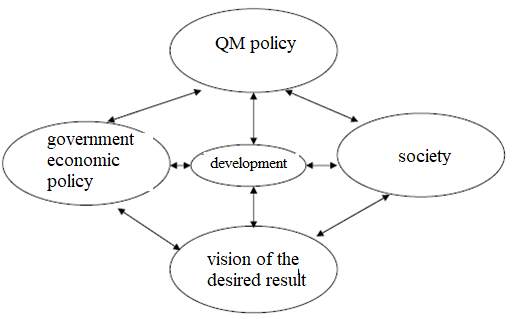
Picture 2 - Factors of influence
It is necessary with the purpose of determination of fundamental directions of development of enterprise, foremost, to analyse and estimate his position in external surroundings yesterday and today and to make an effort спрогнозировать, what possibilities, limitations and риски, for him can arise up in connection with the change of environment.
4.2 Application of SWOT- of analysis
An internal environment is totality of components, their functional intercommunications and participants of productive process, the aims of enterprise will be realized in activity of that.
SWOT is an analysis - it is useful to execute before the acceptance of some administrative decision, S
are strong parties in relation to some criterion, W
are weak parties, O
are favourable possibilities that is created by an environment and her expected changes, T
are threats, dangers, риски that is carried with itself by this environment.
The internal situation of firm is reflected mainly in S and W, and external - in About and Т. SWOT- an analysis is design of marketing strategy time.
Methodology of SWOT- of analysis supposes the exposure of internal strengths and weaknesses of firm, and also external possibilities and threats, and establishing connections between them.
SWOT- an analysis is used for the decision of put or introduction of new tasks, optimization of existent commodities or services, planning and estimation of activity of organization on the whole.
During realization of SWOT- of analysis there is determination of strengths and weaknesses Donetskstandardmetrologia
.
Сила - it what an enterprise succeeded in. She can consist in skills, experience, resources, achievements (the best commodity, perfect technology, the best service of customers).
A weakness is this absence something important in functioning of company, that she does not succeed by comparison to other. When strengths and weaknesses are educed, both lists are carefully studied and estimated.
4.3 Portfolio analysis of services
During realization of portfolio analysis by means of matrix of BCG it is necessary to conduct:
- capture of basic data;
- calculation of rate of height of market for a year;
- calculation of relative market share;
- construction of matrix of BCG.
To the report the methodical going is driven near realization of quality estimation of SWOT- of analysis on an example Donetskstandardmetrologia
:
1. A table is formed for the capture of data.
2. A list of services that is analysed by means of matrix of BCG is made.
Data were then collected on the volumes of sales after 2018 and 2019 year. In addition, analogical data may need on the sales of key competitor (or the expected volume of sales). For comfort, data it is necessary to present in form table.
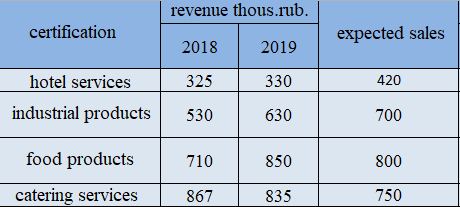
Picture 3 - Table of basic data
3. The annual increase of volumes of sales (profit yields) is expected.Task here - to expect the rate of height of market that settles accounts on a formula ((Current year)/(Last year)*100%).
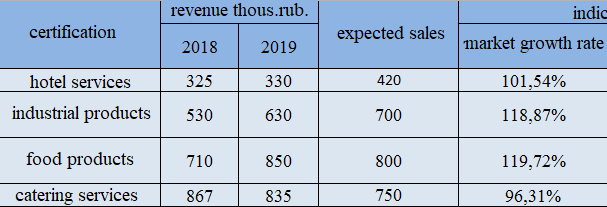
Picture 4 - Rate of height of market
4.Expecting a market growth rate for analysable services, it is necessary to count up a relative market stake. Methods to do it a few. Classic variant - to take the volume of sales of analysable product and divide her by the expected volume of sales. Settles accounts on a formula ((Current year)/ООР*of 100%).

Picture 5 - the Relative market share
5. Construction of matrix of the Bostonian consulting group. From beginning of coordinates we conduct two axes: vertical (rate of height of market) and horizontal (relative market share). Every axis is gone fifty-fifty, on two parts. The subzero values of indexes (subzero rate of height of market, subzero relative market share) correspond one part, other - high (high rate of height of market, high relative market share). Important question that here coming to decide, what values of growth of market and relative market share rate to take on a for central values, dividing the axes of matrix of BCG in half? Standard values following: for the rate of height of market - 110%, for a relative market share - 100%. But in Your case these values will be other, rate of height of market - 130%, and relative market share - 120% (fig. 6)
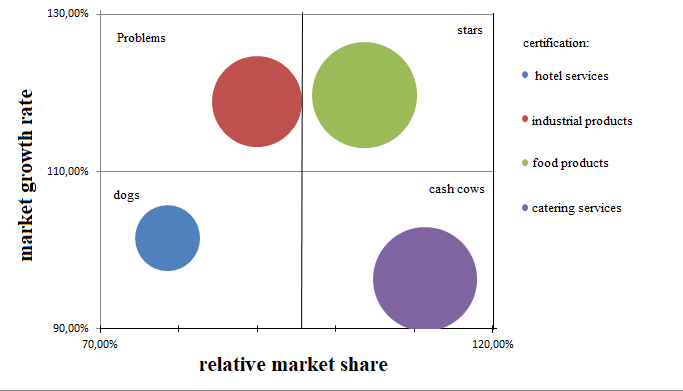
Picture 6 - Matrix of BCG
Conclusions
In the conditions of market economy, marketing is the system of organization of activity of enterprise on development, production and production distribution. Fundamental principles are in his activity - to produce that is for sale, but not to sell that is produced. As a result the production of goods of enterprise reforms in accordance with demand on her.
Success at the market can be attained only in case that an enterprise studies a market, demand, taste and desires of consumers, produces commodities being in demand, affects market and demand in its own behalf.
During the decision of the put tasks, the basic functions of marketing were considered, which it is been:
- study and analysis of demand;
- exposure of necessities, prognostication of market situation;
- development of new commodity and his positioning at the market;
- pricing and development of price strategy; planning of commodity assortment;
- organization rational commodity of motion; sales promotion and forming of demand;
- analysis, planning, realization and control of marketing activity.
In research requirements are analysed to marketing in basic bonuses and standards in quality. Most universally recognized the models of bonuses are considered in quality E. Deming (Japan), М. Baldridge (THE USA), European fund of management of quality (European Foundationfor Quality Management - EFQM). In Russia an analogue is a national competition on the competition of bonus Governments Russian FEDERATION in area of quality. The comparative analysis of marketing is conducted in international bonuses in area of management by quality.
The methodical going is in-process worked out near a management by marketing activity of enterprise on the example of PEST- of analysis, SWOT- of analysis, matrix of BCG.
Analysis of environment - it very important for making of strategy of organization and very difficult process, requiring the attentive watching of what be going on in an environment processes, estimation of factors and handshake between factors and those strengths and weaknesses of enterprise, and also by possibilities and threats that is celled in an environment. Obviously, that, not knowing that takes place in external surroundings and not developing the internal competent parties, an enterprise very soon will begin to stand losses.
It is possible to draw conclusion by virtue of aforesaid, that only the correct variant of behavior of enterprise for the achievement of the effective long-term functioning and successful development is enhanceable attention to realization of analysis of external surroundings. It implies realization of PEST-analysis that gives an idea about position of company. Only at this condition it is possible to count on efficiency of the accepted strategic and operative administrative decisions.
SWOT- an analysis is a difficult enough process this fact undeniable. One of possible explanations is the state of uncertainty in the correct choice of his methodology. During work the common concept of SWOT- of analysis is exposed, all are considered his component, such substantial elements, as process of forming of methodology of SWOT- of analysis, his maintenance, analysis of external and internal environment, are reflected.
Experience of the use of matrix of BCG showed that she is useful at determination of strategic positions of enterprise, and also at allocation of strategic resources on the nearest prospect. However it is necessary to mark that before to use the matrix of BCG for an analysis, it is important to make sure in that a height of volume of highly sought of service can be the reliable index of prospects of development, and relative position of service in competitive activity it is possible to define on her stake at the market.
References
- Менеджмент качества. Качество организации. Руководство по достижению устойчивого успеха организации: ISO 9004:2018 [действует с 03-04-2018] – К.: Федеральное агентство по техническому регулированию и метрологии, 2018 - с. 40
- Секерин В. Д. «Основы маркетинга» М.:КноРус 2011. – 219с.
- Момот А.И. «Менеджмент качества и элементы системы качества» Учебник – Донецк: НОРД-ПРЕС.2005. – 320 с.
- Брюс Д. Хендерсен Продуктовый портфель. Бостонская консалтинговая группа BCGReview: Дайджест. – М: Бостонская консалтинговая группа, 2008
- Методика PEST для анализа внешней среды предприятия [Электронный ресурс] – Режим доступа: http://powerbranding.ru/biznes-analiz/pest/#f
- SWOT анализ: основы метода и ключевые элементы [Электронный ресурс] – Режим доступа: http://powerbranding.ru/biznes-analiz/swot/
- Сильные и слабые стороны предприятия – [Электронный ресурс] – Режим доступа: https://studfiles.net/preview/1976839/page:8/
- Портфельный анализ - это этап стратегического планирования – [Электронный ресурс] – Режим доступа: http://finvopros.com/portfelnyj-analiz-eto.html
- Матрица БКГ. Матрица Бостонской консультативной группы – [Электронный ресурс] – Режим доступа: http://www.stplan.ru/articles/theory/bkg.htm
- SWOT анализ: основы метода и ключевые элементы [Электронный ресурс] – Режим доступа: http://powerbranding.ru/biznes-analiz/swot/
